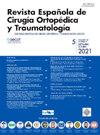[Translated article] Surgical treatment of non-displaced subcapital hip fracture: Femoral Neck System vs. cannulated screws. Comparative study
Q3 Medicine
Revista Espanola de Cirugia Ortopedica y Traumatologia
Pub Date : 2025-07-01
DOI:10.1016/j.recot.2025.04.007
引用次数: 0
Abstract
Objective
The objective of this study is to compare the outcomes of using the Femoral Neck System (FNS) (DePuy Synthes®) versus the use of cannulated screws (CS) in the surgical treatment of non-displaced subcapital hip fractures.
Materials and methods
A retrospective cohort study was conducted on non-displaced subcapital hip fractures treated with CS or FNS between 2020 and 2023, with a minimum follow-up of one year. A total of 28 patients were included, 14 treated with CS and 14 with FNS. Demographic, radiological, clinical, and functional variables were analyzed.
Results
In the CS group, 64% were male, with a mean age of 66.5 years (SD 14.9) and an average follow-up of 22 months (range, 12-36 months). In the FNS group, 57% were male, with a median age of 60.8 years (SD 13.78) and an average follow-up of 16 months (range, 12-24 months).
Regarding functional outcomes, no significant differences were found between FNS and CS in the Harris scale: 94.21 ± 11.55 for FNS and 96.50 ± 6.9 for CS (p = 0.618).
The total postoperative complications (FNS/CS) were 7.1% versus 43%, and implant failure with conversion to total hip replacement was 0% versus 43%, both significantly higher in the CS group (p = 0.047; p = 0.016, respectively). The FNS also presented a lower rate of avascular necrosis (0% versus 11.1%, p = 0.391) and nonunion (0% versus 20%, p = 0.163), although these differences did not reach statistical significance.
Conclusions
Although both treatment methods, cannulated screws and the FNS, showed similar short-term functional outcomes in the management of undisplaced subcapital femoral fractures, the FNS demonstrated a significantly lower rate of complications and reoperations. These results suggest that the FNS could be considered a safer and more effective option compared to cannulated screws.
非移位性髋关节下骨折的手术治疗:股骨颈系统vs空心螺钉。比较研究
目的本研究的目的是比较股骨颈系统(FNS) (DePuy Synthes®)与空心螺钉(CS)在非移位髋关节下骨折的手术治疗中的效果。材料和方法对2020年至2023年间接受CS或FNS治疗的非移位髋关节下骨折进行了回顾性队列研究,随访时间至少为1年。共纳入28例患者,其中CS组14例,FNS组14例。分析了人口统计学、放射学、临床和功能变量。结果CS组患者中男性占64%,平均年龄66.5岁(SD 14.9),平均随访22个月(范围12 ~ 36个月)。FNS组57%为男性,中位年龄60.8岁(SD 13.78),平均随访16个月(范围12-24个月)。在功能结果方面,FNS和CS在Harris量表中无显著差异:FNS为94.21±11.55,CS为96.50±6.9 (p = 0.618)。术后总并发症(FNS/CS)为7.1%比43%,假体失败转化为全髋关节置换术为0%比43%,CS组均显著高于前者(p = 0.047;P = 0.016)。FNS组的缺血性坏死发生率(0%比11.1%,p = 0.391)和骨不连发生率(0%比20%,p = 0.163)也较低,但差异无统计学意义。结论空心螺钉和FNS在治疗未移位的股骨干下骨折的短期功能效果相似,但FNS的并发症和再手术率明显较低。这些结果表明,与空心螺钉相比,FNS是一种更安全、更有效的选择。
本文章由计算机程序翻译,如有差异,请以英文原文为准。
求助全文
约1分钟内获得全文
求助全文
来源期刊

Revista Espanola de Cirugia Ortopedica y Traumatologia
Medicine-Surgery
CiteScore
1.10
自引率
0.00%
发文量
156
审稿时长
51 weeks
期刊介绍:
Es una magnífica revista para acceder a los mejores artículos de investigación en la especialidad y los casos clínicos de mayor interés. Además, es la Publicación Oficial de la Sociedad, y está incluida en prestigiosos índices de referencia en medicina.
 求助内容:
求助内容: 应助结果提醒方式:
应助结果提醒方式:


